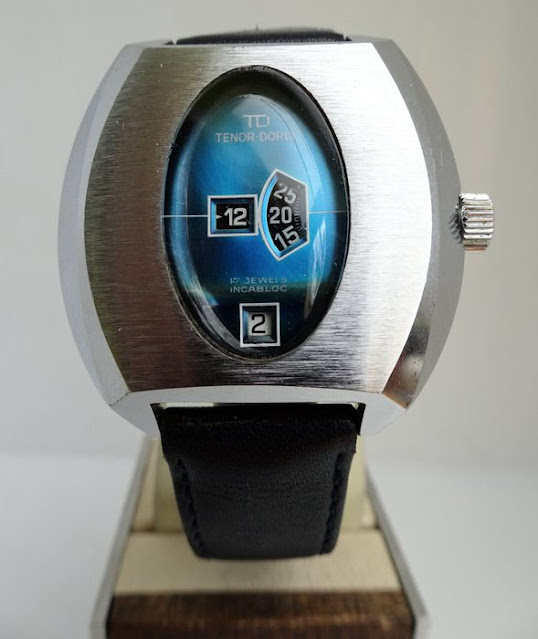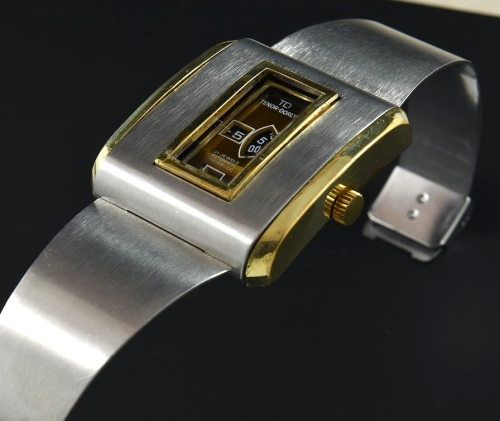By Bruce Shawkey
Gallet can trace its roots all the way back to 1466 when Humbertus Gallet tinkered with various metals and was recoreded in various census records as a horloger or clock maker. The Gallet company went to great pains and expense to trace Gallet's geneology to gain bragging rights as the world's oldest watch company.
But the real story of Gallet began in 1826 when Julien Gallet (1806–1849) founded his company in La Chaux-de-Fonds, Switzerland and began distributing pocket watches all across Europe.. In 1855, Julien Gallet's son Léon (1832–1899) further expanded distribution to help meet Europe's increasing demand for watches. In 1864, Léon's brother, Lucien Gallet (1834–1879), established the company's first U.S. location in Chicago, with a New York City office following soon after. Together with Jules Racine, a cousin of the Gallet brothers living in the U.S., the company began its expansion into the American market.
Due to the American consumer's preference for domestically styled products, the Gallet Company created numerous new lines to effectively compete with American brands. While the names that appeared on the dials and the overall appearance and function of these watches were tailored to American tastes, all cases and movements continued to be produced in Gallet's La Chaux-Fonds workshop. Each of the numerous brands were designed to target a different demographic. Lower priced watches were supplied to the average working man, as well as expensive high-grade and complicated timepieces in solid gold cases for the wealthy. By the end of the 19th century, Gallet selling more than 100,000 timepieces per year and was beginning to transition into wrist watches.
I want to take a break here and talk about of the first wristwatches for which Gallet supplied the movements.
A while ago, my friend Stan Czubernaut found what he believed was one of the first wrist watches ever made. It was made by Gorham Co. for members of the European Mounted Infantry so that the time could be read while riding a horse without the tricky maneuver of pulling out a watch of the soldier's pocket . A date marking on the underside of the dial was engraved 8/94, which meant the watch had been built in August of 1894. Gorham Co., was located in New York, NY. They offered the watch for $15. The true identity of the watch movement was Gallet. This beats the old record generally believed to be held by Omega, which is confirmed to have made a man's wristwatch in 1903. Stan completely restored the watch and sold it with what was believed to be the original leather band, as it was sewn right on to the watch. It was quite fragile, as you might expect for being 124 years old, but it was all there, including the buckle. Stan even contacted the Gallet company, and they were anxious to cooperate with Stan's research, but were unable to find anything in their archives. Stan was able to find to find the ad from Gorham in an obscure Wiki-journal that read Gallet made "bracelet watches" for members of the European Mounted Infantry in this year, but none has ever surfaced. Way to flush out those details, Stan!




OK, back to the history of Gallet:
When the worldwide economic downturn of the 1930s caused international trade to plunge, Gallet changed its focus to the manufacture of professional-use timepieces (hand-held timers and chronograph wristwatches) to allied military and industrial clients during the years leading up to and through World War II. During this period, the Gallet's sales again surpassed 100,000 units annually. A wartime Gallet timepiece of particular renown was the Flight Officer time-zone chronograph, which is still being produced today. Commissioned by Senator Harry S. Truman's senatorial staff in 1939 for the United States Army Air Force, this wristwatch made it possible to calculate changes in the time as a pilot flew across lines of longitude. In Gallet produced the Multichron Petite. The Petite is one of the first wrist chronographs engineered exclusively for enlisted women assigned to technical and scientific tasks during World War II. Powered by the 10 ligne Valjoux 69 movement, and measuring only 26.6mm in diameter, the MultiChron Petite became the smallest mechanical chronograph ever manufactured.
With the end of World War II, and the death of Georges, son Léon Gallet assumes management of the Gallet Company. Only minor changes are needed to transform the appearance of Gallet's military style watches into trendy chronographs for sportsmen and civilian pilots.After the war, Gallet's reputation spread to civilians and professionals in the fields of aviation, sports, medicine, and technology. Their success continues through the '50s and well into the '60s.
The '70s brings with it the quartz crisis, and Gallet is not spared. Upon the death of Léon Gallet (1899–1975), sons Pierre and Bernard assume management of the company. They acquire the Racine Company, which has been struggling as well.
The history of Gallet bounces around from owner to owner for the next couple of decades, but is eventually acquired by David Laurence, who becomes a sort of patron saint for Gallet. He goes to great lengths to restore Gallet's standing in the watchmaking making pantheon. His efforts include sponsoring a temport exhibit at the the National Watch and Clock Museum featuring numerous personal timepieces and accompanying stories of those who have served their countries for the last 250 years. Watches in the exhibit included George Washington's pocket watch, the Gallet chronograph worn by Fred Gerretson while serving as war photographer during the Invasion of Normandy, and the Gallet wristwatch worn by 2nd LT James Richard Hoel when his plane was shot down in the Netherlands by the Germans during WWII. Hoel was sent to the prison camp Stalag Luft III, about 100 miles southeast of Berlin, which was portrayed in the 1963 movie "The Great Escape". He was among the imprisoned officers who helped dig the tunnels as depicted in the movie.
With the support and assistance of David R. Laurence, NAWCC installs a permanent exhibit entitled "At Arm's Length: The History of the Wristwatch". The exhibit provides a comprehensive view of the evolution of the wristwatch, from the small pocket watches that were first strapped to the wrist in leather holders, through the numerous technological advancements in wristwatch functionality during the 20th century, and concluding with the wrist-worn timekeeping marvels of the present day.
let's look at some of Gallet's wrist watches through the decades.

















































